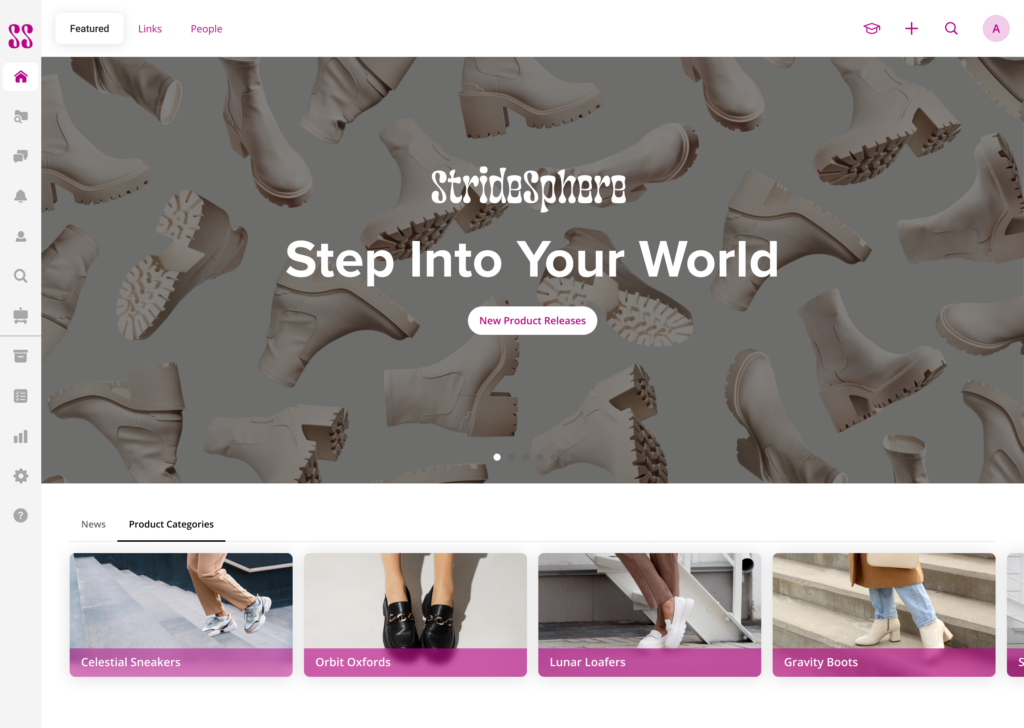Most sales enablement platforms weren’t designed with enterprise sales needs in mind. Enterprise workflows and systems are often complex, and can involve employees on many teams working with thousands of documents across several repositories, in many verticals and different countries.
With this many moving parts, each enterprise company needs something slightly different from their sales enablement system. Manufacturing sales enablement teams for instance, have different needs from financial services or retail.
Despite this variety, most sales enablement software companies only offer one standardized platform, and expect their clients to change their workflows and adapt. Sometimes this just requires an onboarding period — which is normal for any new sales tool — and the sales enablement solution works perfectly.
Other times, the entire sales organization onboards to the new enablement platform and realizes several months later that it will never be a perfect fit — because the system wasn’t designed for their workflows in the first place. Now the platform that was supposed to simplify sellers' lives just becomes another source of friction and frustration, despite a massive investment.
This is a catastrophic waste of time and resources.
The alternative is to custom-tailor the sales enablement platform so it’s designed for your workflows, rather than the other way around. And that’s exactly what we do at Bigtincan.
Below we’ll show you what that looks like, explain how it could work for your organization, and give you an overview of three other sales enablement tools that could work for an enterprise organization.
Note: The best and easiest way to see how Bigtincan would work for you is to book a demo. We’ll walk you through the platform step-by-step and show you how the platform could be adapted to your needs.
How Bigtincan creates custom-tailored sales enablement solutions for enterprise organizations
The key difference between Bigtincan and other standard sales enablement platforms is that Bigtincan is easily custom-tailored to fit the workflow of each organization. This customization can easily be done by us, at Bigtincan, or by our customers to fit their organizational needs.
Consider the following two implementations of Bigtincan. Both look different aesthetically, but more importantly, they offer different functionality.
Example: Enterprise manufacturing company enablement

For example, the Uplift template (above) is designed for a B2B sales organization at a hypothetical manufacturing company. Manufacturing sales reps are typically on the road and have to sell products from dozens, if not hundreds, of product lines, potentially all during one deal, so the interface is optimized for that workflow.
Notice how the interface allows the user to quickly swipe through different product lines for different types of customers and dive into the most important sales collateral for each one. The "Products & Services" button opens to content with product details and could include training videos, manuals, and more.
Example: Enterprise retail company enablement

On the other hand, retail salespeople have to navigate new promotions and varying product lines on the fly, so this instance of Bigtincan is built to keep that information front and center.
For example, if a retail customer has a question about a new product line or a recent promotion, the seller can quickly:
- Review the "New product releases" section at the top of the screen. The section pulls in dynamic data from a promotions calendar, so the information is always fresh and updated.
- Dive into any of the product lines at the bottom of the interface to answer specific product questions or show and email the customer a digital brochure.
While on break, the seller can use the left navigation to view their profile, communicate with coworkers, take assigned sales trainings, or even clock out when their shift is done, depending on how it's customized for that company and rep.
Work with Bigtincan Customer Success to custom-tailor the platform to fit your organization’s needs
A crucial part of the onboarding process for Bigtincan is making sure the platform is set up perfectly to fit your organization’s workflow. We help you do this during and after the sales process either enabling you to configure the platform on your own, or for us and our Customer Success team to do it for you.
The process starts during the product demo where we walk through the Bigtincan platform and talk about your existing sales process. We remain focused on your success, throughout the buying process, onboarding, and through every step we take together to maximize the value you get from your investment in Bigtincan.
Typically the platform rollout happens in stages. The Bigtincan platform is exceptionally adaptable to your workflows, but some tasks — digitizing an enormous product catalog, for example — still take a bit of time and training to fully adopt.
We’ve worked with many enterprise organizations (including seven of the Fortune 10 organizations), and will tell you based on experience when, where, and how to launch each part of the solution for a smooth rollout and easy adoption. Book a demo to learn more and see how this process could work at your organization.
Customize your sales enablement experience, or use stock functionality
Finally, Bigtincan offers a standard sales enablement implementation for teams that don’t require in-depth customization.
Bigtincan goes beyond Sales Content Management
Both of the examples above are custom-tailored to match distinct sales workflows, and both are built using the same thoughtfully-designed components of the Bigtincan platform, including:
Sales Content Management
The Bigtincan content management system features:
- AI-powered searches so you can spend less time tagging and manually organizing files, and instead, find anything you need with a few clicks. Then you can reallocate the time previously spent organizing files to servicing customers or selling prospects.
- Personalize content suggestions powered by AI- and machine learning, so the next right content is always at the sellers’ fingertips.
- Integrations with any third-party content repository so Bigtincan can act as a single source of truth for all sales assets, regardless of where the marketing team stores content.
- Offline and mobile functionality with storage optimization driven by artificial intelligence, so sellers will always have the latest version of a file, even if they forget to manually update the version they have stored on their desktops.
- Salesforce and other customer relationship management software integrations so sellers can access content from the CRM, and automatically update sales records anytime they send content to a buyer, reducing time spent updating the CRM while maximizing the amount of valuable data in the system.
- Buyer and seller analytics so sellers can see how decision-makers interact with content and adapt follow-up and outreach accordingly, and sales managers can see sales performance metrics at a glance.
In short, even if you didn’t modify a single pixel of the Bigtincan platform, your team would still have a cutting-edge sales enablement user experience.
Learn more about Bigtincan content management for enterprise.
Learning and Coaching
Bigtincan Learning is designed to be used alongside the LMS that lives with HR or the L&D department, not as a replacement. With Bigtincan Learning, company leaders can quickly author new content and distribute it to reps on a mobile-first, AI-powered platform that’s perfect for the latest learning techniques, such as gamification, just-in-time- and micro-learning.
Sales leaders can also assign reps tasks, provide feedback with video coaching tools, and develop libraries of winning sales pitches and other playbooks for training and reference.
Learn more about Bigtincan Learning for enterprise.
Sales Engagement Hub
With the recent acquisition of Clearslide (now Bigtincan Engagement Hub), Bigtincan now offers more features to help sellers engage with buyers more effectively. Sales engagement platform features include:
- Buyer enablement features, such as digital salesrooms, to help create amazing buyer experiences.
- Sales presentation and customer engagement analytics, so sellers can see how buyers are interacting and reacting when they share content and adjust in real-time.
Learn more about Bigtincan Engagement Hub.
Advanced customization options and functionality
In addition to the main components mentioned above, Bigtincan offers advanced functionality in areas such as catalog management, assisted and virtual reality, language analytics and feedback, and a plethora of custom widgets that can be created using the Bigtincan API and SDK.
White-glove onboarding and customer support
All of the features above are brought together with high-touch customer onboarding and sales enablement support. We’ll help you:
- Map out your sales process and enablement practices.
- Provide the technology and support needed to modernize, streamline, and accelerate your sales cycle.
- Help launch your custom-tailored sales enablement platform across the entire organization.
- Provide ongoing support as needed for your ongoing success.
We’ve used this same process for companies like ThermoFisher, GUESS, General Motors, American Airlines, and more. To see the Bigtincan sales enablement platform in action and discover how it could work at your organization, book a demo today.
Other enterprise sales enablement platforms
Bigtincan works right out of the box without customization but truly shines if you need a platform custom-tailored to your workflow. However, if you don’t need the flexibility, it may be worth checking out any of the following three sales enablement platforms. They each have worked with enterprise companies in the past, though they offer far less in the way of platform customization.
Seismic

The Seismic platform includes tools to manage content, automate document creation, and analyze buyer and seller actions (though they rely on third-party vendors to offer coaching or training tools).
Unique to the Seismic platform is their ability to automate almost any task on the platform, though this requires quite a bit of up-front work to set up correctly. Like Bigtincan, they were founded in 2010, and have more than a decade of experience serving enterprise customers.
Click here to learn more about Seismic.
Showpad
Showpad offers tools for content management, sales analytics, and coaching for the sales team. All of these tools can be deployed quickly, which leads to solid implementation times. The flipside of quick implementation, however, is a lack of flexibility — the Showpad website mentions some customization features through their API and SDK, but they’re limited compared to what’s available on Bigtincan.
Click here to learn more about Showpad.
Highspot
Highspot offers content management, analytics, and some sales management and coaching features. Their spot-based content management solution and clean user interface make them a favorite among front-line sellers.
Click here to learn more about Highspot.
Still on the fence about which platform is best for you? The best and easiest way to get your questions answered is by booking a demo of Bigtincan.


